Air Ontario – Aircraft Fleet History
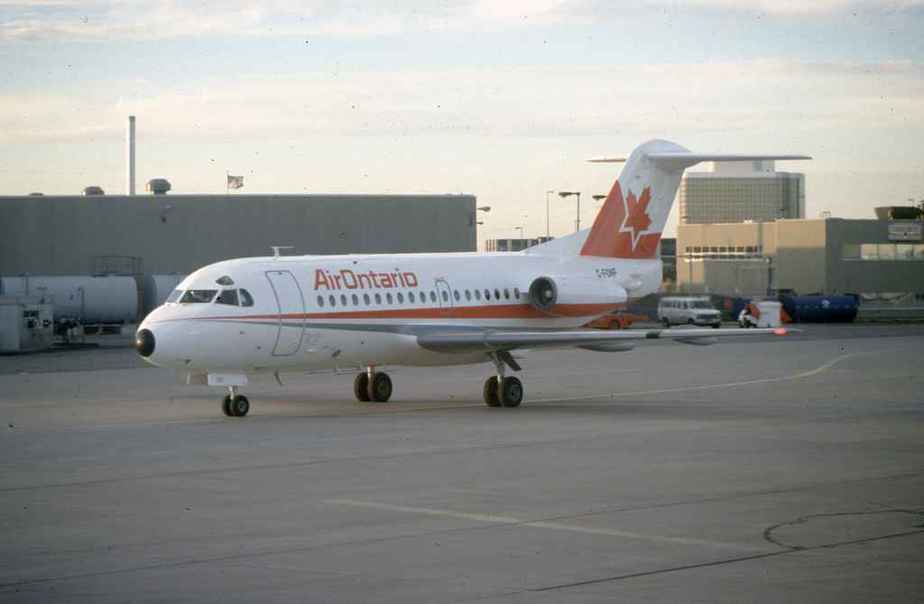
Air Ontario F28 C-FONF YYZ 1988
Air Ontario – Great Lakes Airlines
Airline History written by Dr. John Blatherwick

Dr. John Blatherwick
The upper three quarters of the tail was red and displayed a white map of the Great Lakes within a white circle. Once the Convairs arrived, the Beech 18, was sold to Air Windsor and the two DC-3s sold to Pem Air of Pembroke. When London, Ontario, was added to the Sarnia to Toronto route in 1973, four more Convair 440s were purchased from Linjeflyg of Sweden. These white aircraft had a broad blue cheat line above a thin white cheat line and a thin dark blue cheat line below both and had an all-white tail. One of a variety of symbols was found on the tail, including a map of the Great Lakes in blue but with no circle, a stylized ‘GLA’ or no symbol at all.
With the additional aircraft, Peterborough, Ottawa and Kitchener were added to flights from Toronto. This rapid expansion of routes using old, unreliable equipment proved to be uneconomical and the three cities were quickly dropped. For a short period in 1975, all operations were halted except the Sarnia to Toronto route. An analysis of the problems faced by the airline showed that many flights had to be unexpectedly cancelled due to aircraft unserviceability; the new routes had not been properly publicized; and no feasibility studies had been made before opening new routes.
A group of Toronto businessmen bought the airline in 1975 and started to rejuvenate it. They moved the Toronto operations from Terminal One to Terminal Two and turned over the flight handling to Air Canada in Toronto and London. Air Canada also handled all Great Lakes’ ticket sales and reservations on its computerized system. The Toronto to Ottawa via Peterborough route was resumed in April 1976 but Kitchener was never reintroduced to the schedule.
When Air Canada retired its Viscounts, there was a hockey charter market for a forty to fifty passenger aircraft in Southern Ontario. Professional hockey teams. however, refused to fly in old piston equipment and the decision was made to purchase Convair 580 aircraft from Allegheny Airlines. The Convair 580 was .a Convair 340 piston aircraft re-engined with twin Allison Jet Props. The interior of this aircraft was the same size as the Convair 440 except that the galley and lavatory had been moved to the front of the plane permitting two additional rows of seats to be added, thus increasing the capacity to fifty two passengers.
These aircraft were all white with a brown cheat line through the windows. Below this an orange cheat line broadened downwards as it swept aft. Below this was another brown cheat. The new company logo was displayed on the white tail and the airline’s name appeared in brown on the upper fuselage. The Convair 440s were kept for a short time as backup aircraft before being sold or broken up.
The Convair 580 entered service with the company in March 1976, using experienced Allegheny pilots as co-pilots. Four aircraft were purchased within a year and the company was once again on solid financial footing.
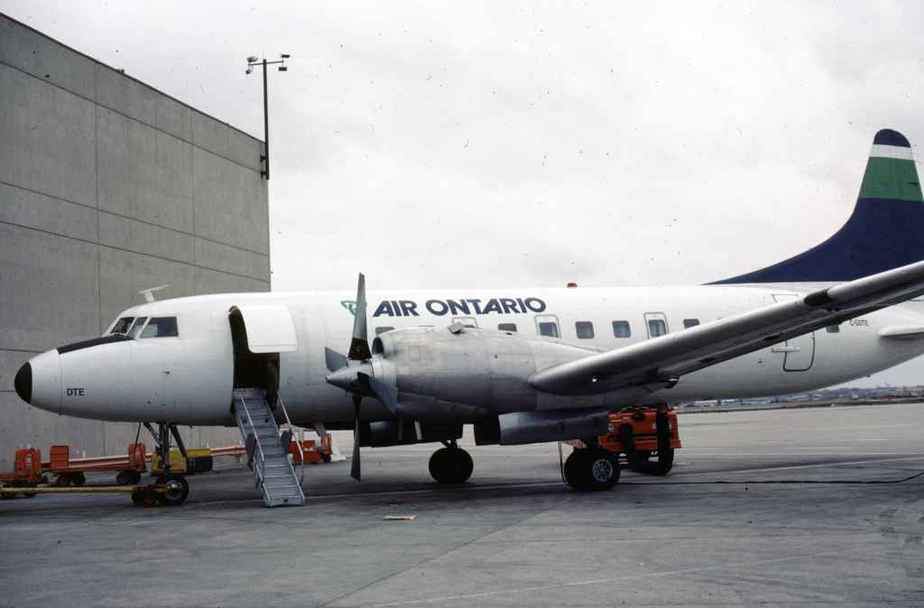
Air Ontario CV580 C-GDTE YYZ May 1982
In October 1976, Great Lakes took over all but one flight per day between London and Toronto from Air Canada.
In January 1977, the company moved its headquarters from Sarna to London, Ontario, and later that year purchased Flightexec Ltd. of London, which operated executive aircraft charters in southwestern Ontario using a Piper Aztec. The company continued to operate Flightexec Ltd. as a separate airline.
Great Lakes applied for the Toronto — Sault Ste Marie – Thunder Bay – Dryden – Winnipeg route relinquished by Transair when it merged with PWA, but the route was awarded to Nordair. In need of expanding its routes, Great Lakes also hoped that Air Canada would phase out its short DC-9 routes in Ontario (such as Toronto to North Bay and Sudbury), but it would be another decade before these routes would come available to the airline. Thus the company continued to operate with only Sarna, London, Toronto, Peterborough to Ottawa route, with the London to Toronto segment being the most profitable.
During the summer of 1979, Great Lakes began flying small package charters from Toronto to Western Canada. The aircraft involved were stripped of their normal passenger seats and soon Great Lakes Convair 580s were seen frequently in Vancouver, Calgary, Edmonton and Winnipeg. In October of that year, Flightexec added Cessna Citation C-GJTX raising the fleet of this subsidiary to seven aircraft based in London and Windsor.
A fifth Convair 580, added in December 1979, carried the registration C-GJRP, JRP being the initials of the company President, James Robertson Plaxton. Regular scheduled flights and charter flights kept the airline so busy during February 1980 that it was necessary to drop the flights to Western Canada for Purolator Courier until April 1980.
In January 1981, the company again dropped itsToronto to Peterborough and Ottawa service which was picked up by Air Atonabee. In February, Great Lakes Introduced its direct Toronto to Ottawa service operating Monday to Friday only. Great Lakes also formed an off-shore helicopter support division which included five Sikorsky S76As. The S76s were delivered In 1985.
The company changed its name to Air Ontario on April 27, 1981. Convair 580 C-C-DTC was the first aircraft flown in the company’s new colour scheme: a white aircraft with no cheat line, the title ‘AIR ONTARIO displayed in dark purple on the upper fuselage. The purple tail was broken by a horizontal green stripe with a narrow white strip above it.
Purolator Courier services were reduced in March 1981, and discontinued altogether in April, 1981, being taken over by Kelowna Flightcrafi Convair 580s. In December 1981, 50% of the stock of the parent holding company was purchased by the Deluce family of Timmins who were the owners of Austin Airways and White River Air Service.
In April, 1982, an interline agreement was arranged with Wardair permitting passengers in Ottawa or London to connect on Wardair flights at Toronto.
By 1982, the Toronto to Ottawa route was proving to be very successful as the flights were scheduled between Air Canada flights, thus creating very good load factors. The rights for an Ottawa to Montreal service (with no local traffic) were obtained early in 1982 but never used because the company had also received therights to fly London – Ottawa and London – Montreal direct. Aircraft on the London to Montreal route arrived in Montreal from London early in the morning and would sit unused all day before returning to London at night When Eastern Provincial Airways was on strike in January 1983, Air Ontario Convair 580s operated Montreal to Charlo and Chatham daily services.
The company became an international airline in 1983, when it was awarded flights from London to Cleveland. London, Ontario, was now the hub of operations for Air Ontario, with flights to Sarnia, Cleveland, Toronto, Ottawa and Montreal direct from that city.
Early in 1984, Delplax Holdings Limited, the holding company for Air Ontario, tried to buy Nordair but was unsuccessful. A major expansion of the company’s fleet occurred that year when a Convair 580 was purchased from South Africa and five Convair 5803 from Freedom Airlines in the United States bringing the airline’s total to 11 Convair 580s. These aircraft were required for the new routes being opened by the company. Toronto – Hartford and Toronto – North Bay routes began in September, and Toronto – Sudbury was started in November.
The company changed its colour scheme in 1984, adding three cheat lines to the white aircraft. A narrow green cheat line running through the middle of the windows was separated from a broader dark purple line below by a white cheat line. The dark purple tail is split horizontally by a white band with a broader green band
In October 1985, forty-nine percent of Air Ontario shares were sold to Air Canada and Pacific Western Airlines (each receiving half of the shares), while Pelplax Holdings Limited, (owned by the Deluce Farmiy), retained fifty-one percent of the airline. Air Ontario was now established as a commuter airline serving the large national airline (Air Canada) and the rapidly expanding regional airline (Pacific Western).
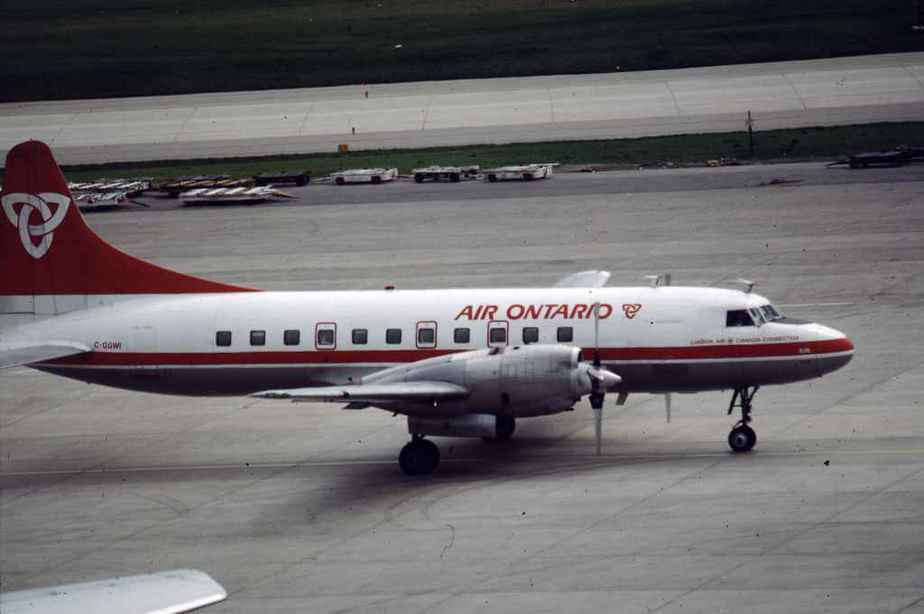
Air Ontario CV580 C-GGWI YYZ 1988
In May 1986, Sault Ste. Marie was added to the Ontario cities served by the company as it continued to take over many of the shorter Air Canada routes which could be better served by the smaller Convair 580s. The company announced plans to build a $3 million hangar and new head office at the London Ontario airport by 1990. In October, the future aircraft plans of the company were announced with an order for 15 Dash-8- 100s (plus four optional) and five Dash 8-300 aircraft. As the two national airlines lined up commuter airlines, Air Canada purchased Air Ontario shares from the Deluce Family and Pacific Western, resulting in Air Canada holding seventy-five percent of the company’s stock.
The beginning of 1987, saw the first Convair 580s dressed in the Air Canada Commuter red and white colour scheme. One Convair, however, flew in an interim scheme displaying the Air Oritario logo on the tail rather than the red maple leaf. The first Dash-8 aircraft arrived in full commuter colour scheme in April and were used on the Sarnia – Toronto – North Bay and Toronto – Cleveland routes. The Air Canada designator replaced Air Ontario’s designator (GX) for all flights shown in the schedule of either airline.
Air Canada, through the purchase of Air Ontario, also acquired 75% of Austin Airways which serviced more than thirty-five centers in Ontario (mostly in the north), and five centers in northern Quebec as well as Minneapolis and Toronto. Austin also switched to four digit AC flight designators in April 1987 and in June
1987: amalgamated with Air Ontario. At that time, Austin Airways was the longest-operating airline in Canada.
In 1988, a strike by Air Ontario pilots in early March grounded the airline until May 4. The new contract with the pilots, expiring in November 1990, provided for a newly-hired co-pilot on the new CATPASS 209 aircraft to make $20,000 a year while a four year captain flying a Fokker F-28 would receive $71,400 per year.
Flights to Trenton and Kingston and those to Kapuskasing were delayed in restarting following the strike. Scheduled flights to Kasabonika, Round Lake, Sachigo. Bearskin Lake, Geraldton and Homepayne were suspended indefinetly; and London — Cleveland was never restarted.

SP4630 Air Ontario CV580 C-GJRP YYZ June1984
Air Ontario joined the other regional airlines in going to small jet aircraft early in 1988, when they acquired two Fokker F-28-1000 jets. These entered service in May on the Toronto – Sault Ste. Marie – Thunder Bay – Winnipeg route, with three flights a day. Some flights on this route would also stop at Dryden and/or Kenora. The airline also began operating the Toronto – Syracuse and Albany route at that time.
In addition to the new jets, Air Ontario purchased ten Commuter Air Transport Catpas 200 (CATPASS 200) aircraft. These modified Beech King Air 200s were planned to replace the Beech 99s and Cessna 402s acquired in the takeover of Austin Airlines. Nine of the Cessna 402s were sold by the time the Cat 200s began arriving in June,1988. Eventually all the Beech 99s, Cessna 402s and Twin Otters were replaced with these aircraft.
During the latter part of 1988, Air Ontario began selling off the Northern Ontario routes it had acquired from Austin Airways. Timmins – based aircraft and routes
were sold to Air Creebec, including most of the company’s HS748 aircraft. The Twin Otters and Beech 99s were sold and the newly-arriving CATPUS 2008 would also be sold. Aircraft and routes based in Thunder Bay went to Bearskin Lake Air Service, and the company’s Thunder Bay – Minneapolis route was dropped.
Air Ontario suffered a tragic accident on March 10, 1989, when its new F-28 jet crashed on takeoff from Dryden. Twenty-four passengers and crew were killed
in the accident which was caused by ice on the wings. Convairs had to be brought back into service to replace the lost jet aircraft.
Through the 1990s Air Ontario operated as a reliable Air Canada Connector serving Air Canada’s connector routes throughout Ontario and the airline was merged into Jazz along with all the other Air Canada Connectors in the late 1990s and early 2000s.

Air Ontario DASH8 C-GJIG YYZ 1987
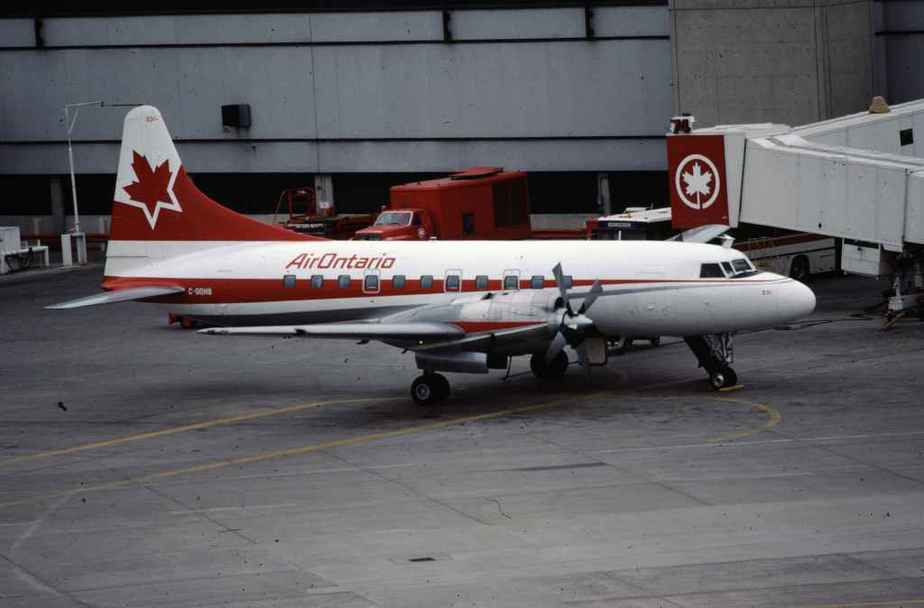
Air Ontario CV580 C-GQHB YYZ May 1988
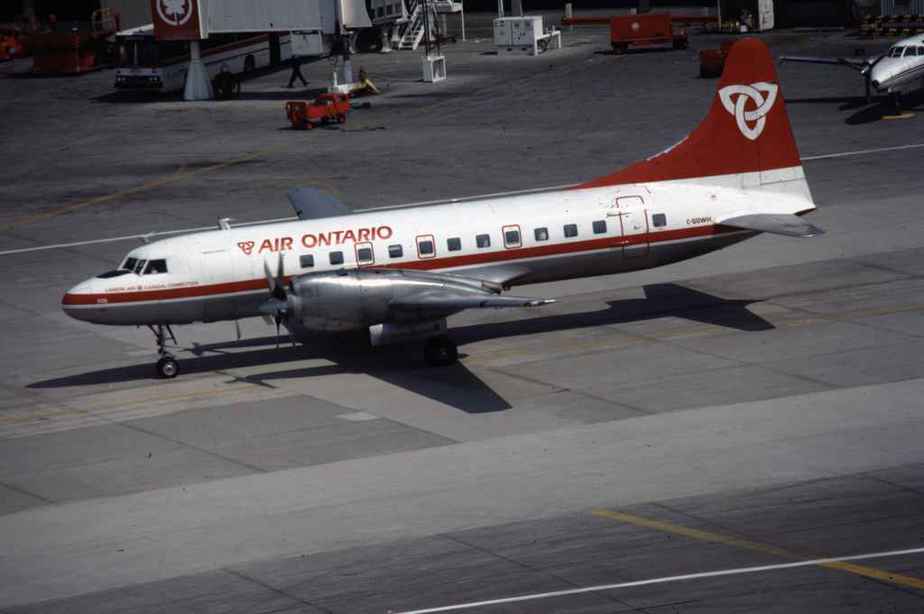
Air Ontario CV580 C-GGWH YYZ June 1987

Air Ontario CV580 C-GGWF YYZ May 1985

Air Ontario CV580 C-GDTD YYZ June 1983
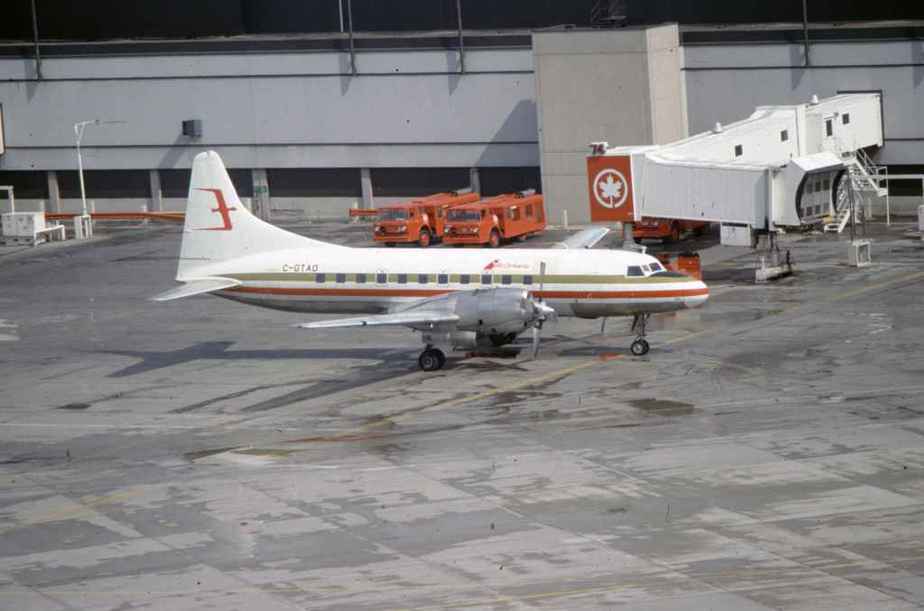
Air Ontario CV580 C-GTAO YYZ May 1988
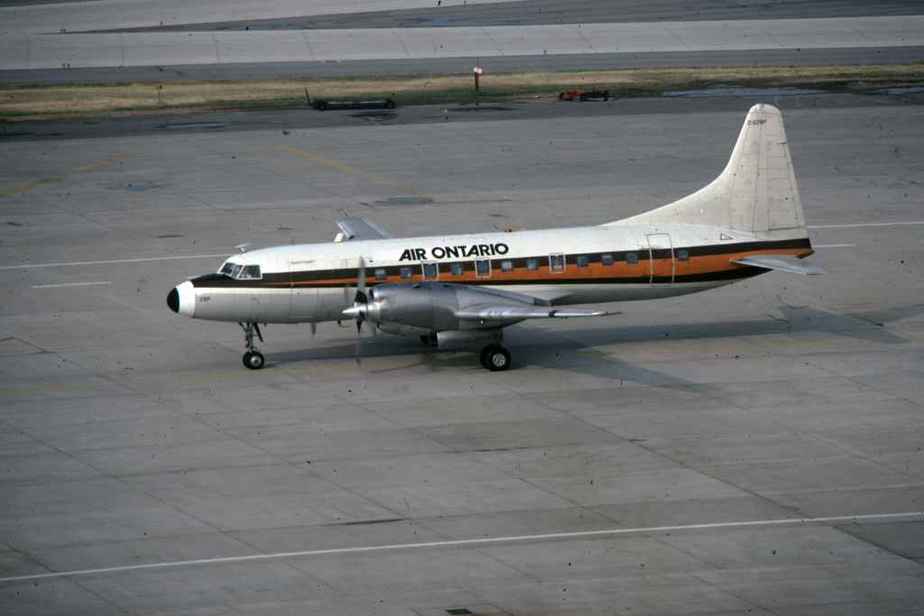
Air Ontario CV580 C-GJRP YYZ July 1983
Tags: Air Ontario, Great Lakes Airlines, Sarnia

No comments yet.